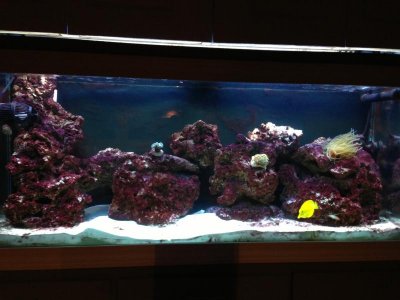mix up enough water to do a large change. get a siphon hose that can reach all your rocks, and do a major cleaning. siphon out all the red slime, its cyanobacteria, not algae. once you get the tank topped off and set back up after your cleaning, shut off the lights. keep the lights out on the tank for 3 days. its ok to pu ton an actininc for a few hours a day to do feedings and such, but thats it. if the tank is in a room that gets natural light, than cover it somehow. on day 2 or 3 mix up another batch of water. at the end of day 3 make sure your lights will come on per their normal schedule on day 4. on day 4 do another water change and get your circualtion pumps so that they are hitting all your rock surfaces, try to avoid low flow deadspots. your red slime should be gone and it should stay gone for a while priovided a few things happen:
1 - test your phospahtes and keep testing a few times a week
2 - reduce your feedings
3 - do more water changes and keep testing your phospahte
you shouldnt need a gfo reacotr yet, i dont see much in the tank, but you could have phosphates getting into the tank from other sources, as mentioned above. If you do have phosphates gettign intot he system via water changes or additives, your cyano will come back...dont worry too much, it LOOKS really bad, but its not hurting anything. you just dont want a lot of it to die off suddenly in the tank, THAT would be bad...thats why you try to remove as much as you can manually befotre turnign out the lights. darkness is the only thing that kills it off safely, you just don twant a tank full of it to die overnight...

